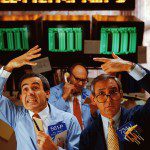A provision in the financial reform law forced the Federal Reserve to disclose the details of the trillions it lent out at the height of the recent financial crisis.
 You can see the data from some of the Fed’s emergency lending programs in our interactive. In all, there were 11 programs–a mess of confusing acronyms like AMLF, TALF, PDCF, CPFF and so on—but generally speaking, they were designed to stabilize the economy by enabling financial firms to keep many forms of lending going at a time when credit was hard to come by. Here’s a rundown of what’s come to light from this data so far.
You can see the data from some of the Fed’s emergency lending programs in our interactive. In all, there were 11 programs–a mess of confusing acronyms like AMLF, TALF, PDCF, CPFF and so on—but generally speaking, they were designed to stabilize the economy by enabling financial firms to keep many forms of lending going at a time when credit was hard to come by. Here’s a rundown of what’s come to light from this data so far.
The big U.S. banks
Following the failure of Lehman Brothers the biggest U.S. banks had tabs with the Fed that ran in the tens of billions on any given day during the worst parts of the financial crisis. Big banks typically got funds through more than one program because they were eligible for different types of loans.
As our interactive shows, Citigroup, Merrill Lynch and Morgan Stanley topped the list, with more than 200 loans each, though Bank of America and Goldman Sachs weren’t far behind. (The Wall Street Journal has helpfully graphed this out.)
In order to take out these cheap overnight loans, banks had to pledge collateral. More than $1 trillion of what they pledged, the New York Times reported, was junk-rated investments. The Fed has said, however, that it hasn’t lost money on this program or on any of the others.
Foreign banks
Foreign banks were also big borrowers under several of the Fed2019s lending programs. UK bank Barclays, Bloomberg reported, took out the single biggest overnight loan, $48 billion, from a program for financial firms pre-approved to trade directly with the Federal Reserve. Under another program, Swiss bank UBS took out close to $75 billion overall, more than any other bank in that program.
While the lending to foreign banks has been a point of criticism since the data’s release, NPR’s Adam Davidson explained that foreign central banks also lent to the overseas arms of U.S. banks and that the Fed felt that in order to stabilize the market, they needed to shore up foreign banks too:
This was two years ago, and over the course of the last two years, when the financial world was falling apart, the Fed had a whole lot of fears. One of the biggest fears was that a bank like, say, UBS, the huge Swiss multinational, they owned billions and billions of dollars in those U.S. subprime mortgage-backed securities, those toxic assets we heard so much about. And the Fed was terrified that if UBS couldn’t borrow from the Fed, they would just sell tons of those at bargain-basement prices. Our mortgage crisis was already bad enough. If we added tens or hundreds of billions of dollars in new mortgage-backed securities just flooding the system, it would have been truly, truly disastrous.
Banks that ended up failing
Though most of these banks survived with the Fed’s help, the Times also pointed out that 20 or so banks that received Fed assistance still failed. Washington Mutual, the largest U.S. bank to fail, received billions before it collapsed and was taken over by JPMorgan Chase. Others included smaller community banks, such as First National Bank of Nevada, First Federal Bank of California and La Jolla Bank. Despite those setbacks, the overall program didn2019t lose money.
Hedge funds and rich investors
One of the Fed’s programs, the Term Asset-Backed Securities Loan Facility, was designed to encourage very broad participation, as long as borrowers met specific eligibility criteria, a Fed spokesman told the Wall Street Journal. The program allowed hedge funds and investors to take out $71 billion in loans from the Fed to buy bonds backed by student, auto and small business loans2014moving these loans off the books of banks and encouraging continued lending based on the heightened investor demand.
As it turned out, the Fed ultimately financed some high-return investments for institutional investors, investors in hedge funds and some individual investors, yielding returns as high as 48 percent in some cases and around 10 percent toward the end of the program, the Journal reported.
One of the borrowers in this program was the hedge fund Magnetar, which, as we reported earlier this year, had helped create more than $40 billion worth of CDOs during the run-up to the financial crisis as part of its strategy to bet against the housing market. As the Journal noted, Magnetar obtained about $1 billion in Fed loans to invest in securities, and most of that remains outstanding.
According to the Fed, 60 percent of the loans extended under this program were paid back early, and all the loans that have not yet been repaid are current.
Big corporations
The only Fed program that lent directly to nonfinancial companies was one called the Commercial Paper Funding Facility, which lent to companies who had a hard time getting short-term loans elsewhere.
As we’ve noted, General Electric received funding through this program, as did AIG, Chrysler, GM, GMAC, Verizon, McDonald’s, Prudential, MetLife, Caterpillar, Harley-Davidson and other recognizable household names, the Journal and Reuters reported. According to the Fed, all these loans were repaid in full.
by Marian Wang
ProPublica


